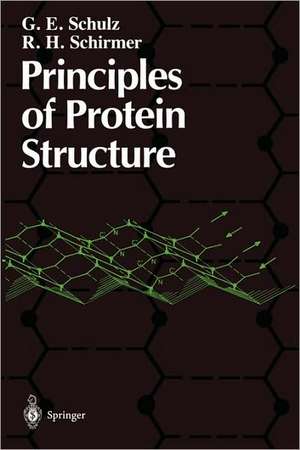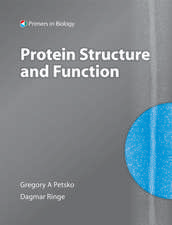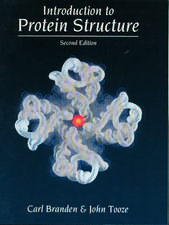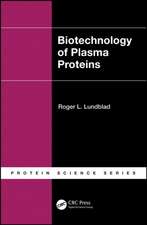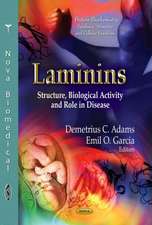Principles of Protein Structure: Springer Advanced Texts in Chemistry
Autor G. E. Schulz, R.H. Schirmeren Limba Engleză Paperback – 12 apr 1979
Preț: 585.26 lei
Preț vechi: 688.54 lei
-15% Nou
Puncte Express: 878
Preț estimativ în valută:
112.02€ • 121.72$ • 94.16£
112.02€ • 121.72$ • 94.16£
Carte tipărită la comandă
Livrare economică 21 aprilie-05 mai
Preluare comenzi: 021 569.72.76
Specificații
ISBN-13: 9780387903347
ISBN-10: 0387903348
Pagini: 320
Ilustrații: XII, 320 p. 5 illus.
Dimensiuni: 155 x 235 x 18 mm
Greutate: 0.45 kg
Ediția:1st ed. 1979. Corr. 2nd printing 1979
Editura: Springer
Colecția Springer
Seria Springer Advanced Texts in Chemistry
Locul publicării:New York, NY, United States
ISBN-10: 0387903348
Pagini: 320
Ilustrații: XII, 320 p. 5 illus.
Dimensiuni: 155 x 235 x 18 mm
Greutate: 0.45 kg
Ediția:1st ed. 1979. Corr. 2nd printing 1979
Editura: Springer
Colecția Springer
Seria Springer Advanced Texts in Chemistry
Locul publicării:New York, NY, United States
Public țintă
ResearchCuprins
1 Amino Acids.- 1.1 The 20 Standard Amino Acids.- 1.2 Why Were Just These Amino Acids Selected?.- 1.3 Colinear Relation Between Nucleic Acids and Polypeptides.- 1.4 Side Chain Properties.- 1.5 Empirical Similarities Between Amino Acid Residues.- Summary.- 2 Structural Implications of the Peptide Bond.- 2.1 Synthesis on Ribosomes.- 2.2 Peptide Bond Dimensions.- 2.3 Steric Hindrance.- 2.4 Conformational Energy.- 2.5 cis versus trans Configuration.- Summary.- 3 Noncovalent Forces Determining Protein Structure.- 3.1 Dispersion Forces and Electron Shell Repulsion.- 3.2 Electrostatic Interactions.- 3.3 Van der Waals Potentials.- 3.4 Hydrogen Bonds.- 3.5 Entropic Forces.- 3.6 Molecular Packing.- Summary.- 4 The Covalent Structure of Proteins.- 4.1 Chain Assemblies.- 4.2 Disulfide Bonds.- 4.3 Enzyme-Controlled Modifications of the Main Chain.- 4.4 Enzyme-Controlled Side Chain Modifications.- Summary.- 5 Patterns of Folding and Association of Polypeptide Chains.- 5.1 Secondary Structure.- 5.2 Supersecondary Structures.- 5.3 Structural Domains.- 5.4 Globular Proteins.- 5.5 Aggregates of Globular Proteins.- 5.6 Hierarchy of Levels.- Summary.- 6 Prediction of Secondary Structure from the Amino Acid Sequence.- 6.1 Probabilistic Methods.- 6.2 Physico-Chemical Methods.- 6.3 Application of Prediction Methods.- 6.4 Evaluation of Prediction Methods.- 6.5 Emerging General Results.- Summary.- 7 Models, Display, and Documentation of Protein Structures.- 7.1 Structural Ingredients.- 7.2 Representations of Complete Structures.- 7.3 Abstract Chain Fold Representations.- Summary.- 8 Thermodynamics and Kinetics of Polypeptide Chain Folding.- 8.1 Thermodynamic Aspects.- 8.2 Speed, Precision, and Limitations of Folding in vitro.- 8.3 Structural Elements in Unfolded Chains.- 8.4 Folding Pathway.- 8.5 The Influence of Ligands.- 8.6 Simulations of the Folding Process.- Summary.- 9 Protein Evolution.- 9.1 Protein Speciation.- 9.2 Phylogeny on the Basis of Protein Structures.- 9.3 Protein Differentiation.- 9.4 Gene Fusion.- 9.5 Convergent Evolution in Proteins.- 9.6 Recognition of Distant Relationships.- Summary.- 10 Protein-Ligand Interactions.- 10.1 Ligand-Binding Sites of Immunoglobulins.- 10.2 Substrate-Binding Sites of Serine Proteases.- 10.3 Haem-Binding Sites.- 10.4 Nucleotide-Binding Sites.- 10.5 Binding Sites for Phosphoryl Groups.- 10.6 Interactions of Proteins With Other Macromolecules.- Summary.- 11 The Structural Basis of Protein Mechanism, Action, and Function.- 11.1 Definitions.- 11.2 Enzyme Catalysis.- 11.3 Biological and Medical Aspects of Protein Action and Function.- 11.4 Skeletal Muscle, a System in Which Protein Action Can be Related to the Overall Performance of an Organ.- Summary.- Appendix Statistical Mechanics of the Helix-Coil Transition.- A.1 Partition Function.- A.2 Probability of a Residue Being in a Certain Conformation.- A.3 Ising Model.- A.4 Zimm-Bragg Model for Helix-Coil Transition.- A.5 Comparision With Experimental Data.- References.
